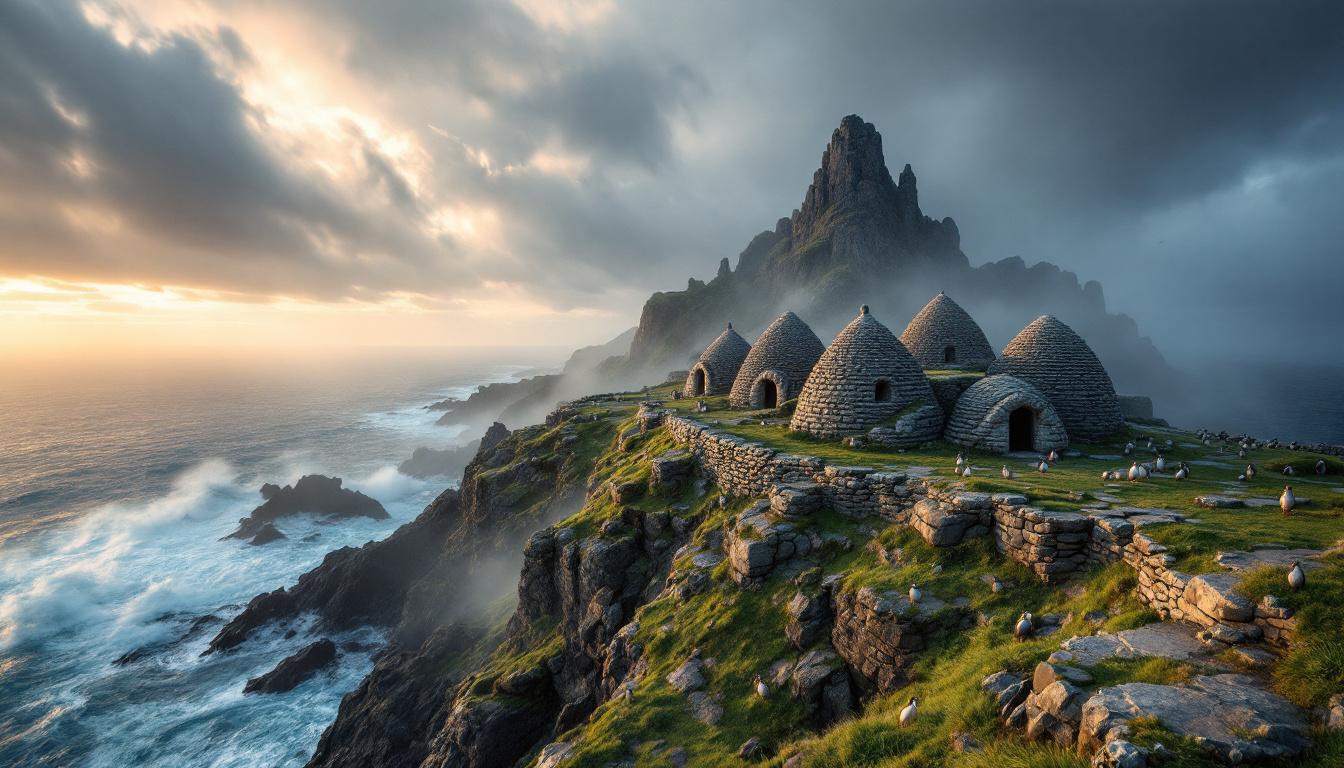Standing on the windswept deck of a fishing boat 11.6 kilometers off the Kerry coast, I watch Ireland’s most extraordinary secret emerge from the Atlantic mist. Skellig Michael rises like a stone pyramid from the waves, crowned with structures that shouldn’t exist—beehive huts built by 6th-century monks that have survived 1,400 years of Atlantic storms without a single nail or drop of mortar.
This is the only place on Earth where you can walk inside intact early Christian monastic cells that predate most European cathedrals. While tourists crowd Mont Saint-Michel’s gift shops, Sceilg Mhichíl—as Kerry locals call it in Irish—remains exactly as medieval pilgrims found it centuries ago.
The statistics alone stagger the imagination: six original beehive huts constructed using corbelled dry-stone technique, their pointed domes engineered to shed rain and resist gales that regularly exceed 100 kilometers per hour. No other early Christian island monastery anywhere preserves this level of architectural integrity.
The engineering marvel that defied 14 centuries
Corbelled construction that modern architects study
Each clochán represents a masterpiece of medieval engineering that contemporary builders struggle to replicate. The monks laid flat stones in overlapping circles, gradually reducing diameter until the dome closes—no scaffolding, no concrete, no modern tools. The largest hut measures 4.65 by 3.10 meters internally, with walls thick enough to house entire families during storms.
Atlantic survival against impossible odds
What makes Skellig Michael globally unique isn’t just age—it’s survival in one of Europe’s most hostile marine environments. The island endures winter storms that generate waves exceeding 20 meters, yet these structures remain watertight after 1,400 years. Engineers attribute this to the monks’ genius: outward-sloping joints that channel rainwater away from interiors, creating self-draining architecture centuries before the concept existed.
The spiritual sanctuary hidden from the world
Monastic life at Europe’s edge
Between the 6th and 8th centuries, Irish monks chose this remote pinnacle specifically for its isolation. They carved 618 stone steps into living rock, terraced impossible slopes for gardens, and created what UNESCO calls “an outstanding example of early Christian monasticism.” No other site preserves the complete daily life of medieval monks—sleeping quarters, oratory, cemetery, and kitchen gardens intact.
Pilgrimage destination that predates Santiago
Long before pilgrims walked to Santiago de Compostela, medieval Christians made dangerous Atlantic crossings to reach Skellig Michael. The monks established the only functioning monastery on an offshore Irish island, creating a spiritual reputation that drew visitors from across Celtic Europe. Archaeological evidence shows continuous occupation until Norse raids forced abandonment in the 13th century.
Access that protects authenticity from mass tourism
The 180-visitor daily limit that preserves magic
Ireland’s Office of Public Works maintains the most restrictive visitor limits of any European heritage site. Only 180 people daily can land during summer months, and boat access depends entirely on Atlantic weather conditions. This isn’t tourism management—it’s cultural protection that keeps Skellig Michael exactly as monks knew it centuries ago.
Physical challenges that ensure respect
The 618 uneven stone steps ascending 180 vertical meters aren’t just access—they’re pilgrimage preparation that filters casual visitors. Children under 12 cannot climb, and adults need genuine fitness for the 45-minute ascent. This natural selection process means everyone reaching the monastery appreciates its extraordinary significance.
The living heritage that changes perspectives
Seabird colonies that share monastic space
Thirty thousand pairs of gannets, puffins, and razorbills nest alongside human history, creating the only heritage site where wildlife and archaeology coexist naturally. The monks designed their settlement to accommodate existing bird colonies—environmental sensitivity that modern conservation celebrates as pioneering ecological awareness.
Star Wars filming location with ancient soul
While recent Hollywood attention brought global recognition, Skellig Michael’s true magic lies in its unchanged spiritual atmosphere. Standing inside a 1,400-year-old monk’s cell, surrounded by carved crosses and prayer niches, visitors experience medieval pilgrimage exactly as intended—no interpretive centers, no gift shops, just stone, sky, and centuries of prayer.
Book your Skellig Michael landing tour through OPW-approved operators from Portmagee or Ballinskelligs, but prepare for weather cancellations that protect this irreplaceable heritage. Some experiences cannot be replicated—they can only be preserved for those willing to make the journey to Europe’s most authentic medieval monastery.
This isn’t just Ireland’s most exclusive heritage site—it’s the only place on Earth where 6th-century monastic life remains perfectly intact, protected by Atlantic isolation that modern tourism cannot breach.
